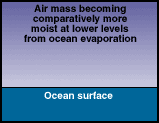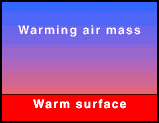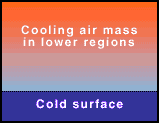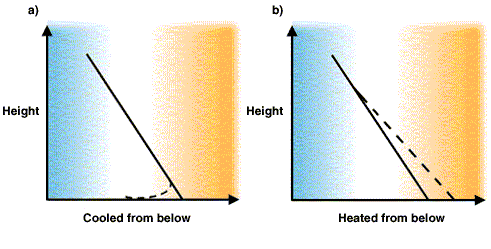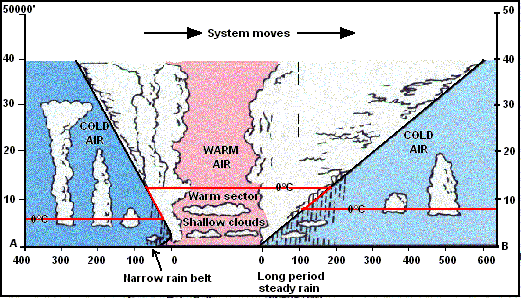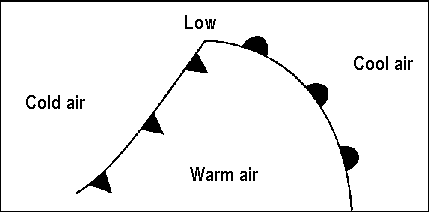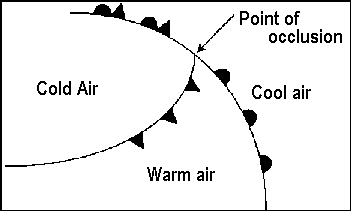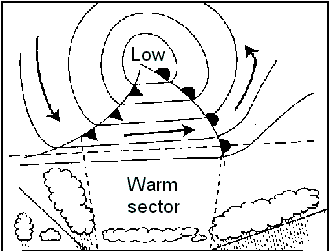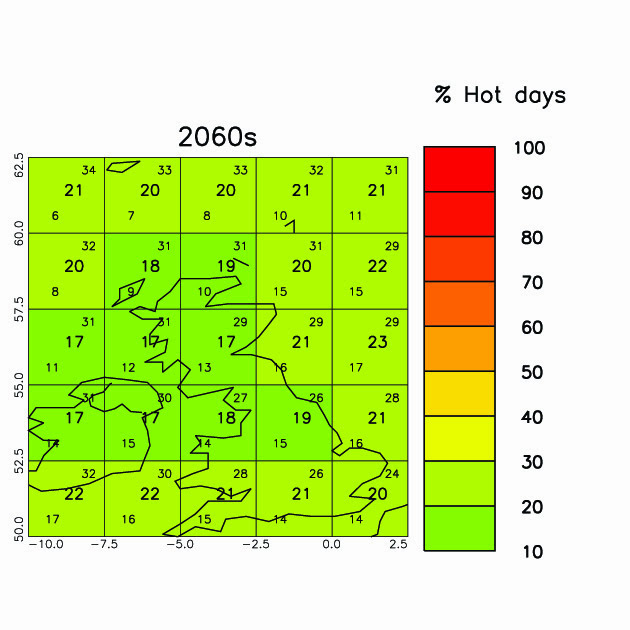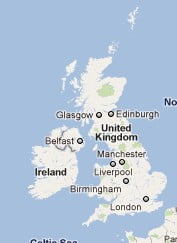Air masses and fronts
1. Introduction
1.1 Definition
1.2 Source of an air mass
1.3 Air-mass modification
2. Air-mass types
2.1 Tropical continental
2.2 Polar continental
2.3 Tropical maritime
2.4 Polar maritime
2.5 Arctic maritime
2.6 Returning polar maritime
3. Between the air masses
3.1 Historical introduction
3.2 Fronts
3.3 Models of mid-latitude depressions
3.4 The passage of a mature depression across the United Kingdom
4. Questions
Air masses are parcels of air that bring distinctive weather features to the country. An air mass is a body or ‘mass’ of air in which the horizontal gradients or changes in temperature and humidity are relatively slight. That is to say that the air making up the mass is very uniform in temperature and humidity.
An air mass is separated from an adjacent body of air by a transition that may be more sharply defined. This transition zone or boundary is called a front. An air mass may cover several millions of square kilometres and extend vertically throughout the troposphere.
The temperature of an air mass will depend largely on its point of origin, and its subsequent journey over the land or sea. This might lead to warming or cooling by the prolonged contact with a warm or cool surface. The processes that warm or cool the air mass take place only slowly, for example it may take a week or more for an air mass to warm up by 10 °C right through the troposphere. For this to take place, an air mass must lie virtually in a stagnant state over the influencing region. Hence, those parts of the Earth’s surface where air masses can stagnate and gradually attain the properties of the underlying surface are called source regions.
The main source regions are the high pressure belts in the subtropics, which produce tropical air masses, and around the poles, that are the source of polar air masses.
As we have seen, it is in the source regions that the air mass acquires distinctive properties that are the characteristics of the underlying surface. The air mass may be cool or warm, or dry or moist. The stability of the air within the mass can also be deducted. Tropical air is unstable because it is heated from below, while polar air is stable because it is cooled from below.
As an air mass moves away from its source region towards the British Isles, the air is further modified due to variations in the type or nature of the surface over which it passes. Two processes act independently, or together, to modify an air mass.
An air mass that has a maritime track, i.e. a track predominantly over the sea, will increase its moisture content, particularly in its lower layers. This happens through evaporation of water from the sea surface. An air mass with a long land or continental track will remain dry.
Fig 2: Modification of air mass by land and ocean surfaces
A cold air mass flowing away from its source region over a warmer surface will be warmed from below making the air more unstable in the lowest layers. A warm air mass moving over a cooler surface is cooled from below and becomes stable in the lowest layers.
Fig 3: Modification of air mass due to surface temperature
If we look at the temperature profiles of the previous example, the effects of warming and cooling on the respective air masses are very different.
Fig 4: Modified vertical temperature profiles (—– line) typical of: a) tropical air cooled from below and b) polar air heated from below on its way to the British Isles. Note that where the air is heated from below the effect is spread to a greater depth of the atmosphere.
2.Air mass types
There are four main types of air mass.
- Tropical continental (Tc)
- Tropical maritime (Tm)
- Polar continental (Pc)
- Polar maritime (Pm)
And two further sub-divisions.
- Arctic maritime (Am)
- Returning polar maritime (rPm)
Each of these air-mass types has its own distinctive combination of properties in terms of:
- temperature;
- moisture content (relative humidity);
- change of lapse rate;
- stability;
- weather;
- visibility.
Tropical continental air affects the British Isles predominantly during the summer. This air mass affects Britain when pressure is high over northern or eastern Europe with surface winds between east and south drawing hot air from North Africa (see Figure 5). This air is initially unstable but very dry. It acquires some moisture in its passage across the Mediterranean Sea but it is still usually too dry to produce any significant amounts of precipitation. South-westerly winds aloft can sometimes inject sufficient moisture to produce high-based showers or thunderstorms.
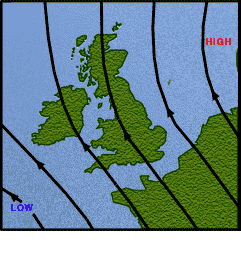
Our highest temperatures usually occur under the influence of tropical continental air (over 30 °C by day and around 15-20 °C at night). Visibility is usually moderate or poor due to the air picking up pollutants during its passage over Europe and from sand particles blown into the air from Saharan dust storms. Occasionally, the Saharan dust is washed out in showers producing coloured rain and leaving cars covered in a thin layer of orange dust.
Tropical continental air may affect the country from March to October, although it is most common in June, July and August. During winter months, tropical continental air is more difficult to identify, but may reach the UK on south or south-easterly winds ahead of slow-moving Atlantic fronts. When high pressure prevails during the winter, strong cooling near the surface makes the air stable, rather than cold and moist. Low cloud and poor visibility may be very persistent under such conditions.
This air mass has a source region over the Eurasian land mass north of 50° N and east of 25° E. It can only be considered a winter phenomenon, as in summer months the land mass becomes very warm, and there are no high-pressure cells develop to ‘push’ the air over the country.
Polar continental air affects the British Isles when pressure is high over Scandinavia with surface winds from an easterly direction (see Figure 6). The characteristics of the air depend on the length of the sea track during its passage from Europe to the British Isles. The air is inherently very cold and dry and it can reach southern Britain after a short sea track over the English Channel, producing weather characterised by clear skies and severe frost. If there is a longer sea track over the North Sea, the air becoming unstable and moisture is added, giving rise to showers of rain or snow. This can be a hazard, especially near the east coast, when the air mass passes over the warmer seas before reaching the colder land surface.
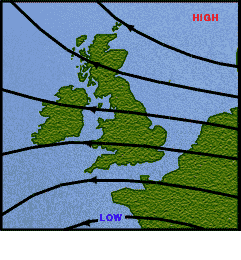
The UK’s lowest temperatures usually occur under this air mass, with temperatures falling below minus 10 °C at night, and sometimes remaining below freezing all day.
Polar continental air only reaches Britain between November and April; at other times of the year, the source region is neither cold nor snow covered and winds from north-eastern Europe bring a more tropical continental form of air.
The source region for this air mass is over the waters of the Atlantic Ocean between the Azores and Bermuda. The air usually reaches the British Isles on south-westerly winds, commonly in the warm sector of a depression or around the periphery of an anticyclone located over central Europe (see Figure 7).
It is warm and moist in its lower layers and during the passage over the cooler waters the air becomes stable and close to saturation. The air mass is modified quickly during its passage across the British Isles and its characteristics vary considerable from place to place depending on exposure to the moist south-westerly flow.
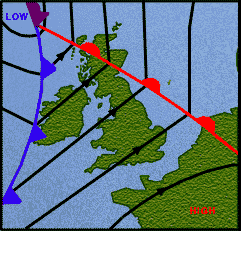
In the western parts of the British Isles, the tropical maritime air is stable and saturated in its lowest layers. As a result, the weather is characterised by much low cloud, drizzle and hill fog. During the winter months the air may reach eastern Britain with very similar characteristics providing the ground is cold, but for much of the year insolation is sufficient to warm the air appreciably.
Visibility is more difficult to quantify. When tropical maritime air reaches our western shores it is near to saturation and any uplift produces low cloud and fog which can reduce visibility to near zero. Following a short land track however, and providing the air has dried out appreciably, visibility can become excellent because the air is inherently clear and aerosol free. Following a lengthy land track, haze particles increase in number and are trapped by the stable air reducing visibility to the moderate category.
Polar maritime air flows towards the British Isles on north-westerly winds from the Arctic regions of Greenland and northern Canada. A typical synoptic situation for such an airflow would have a low pressure centred near Iceland (see Figure 8).
This air starts very cold and dry and during its long journey across the comparatively warm waters of the North Atlantic its temperature rises rapidly. The air temperature rises rapidly, allowing it to become unstable to a great depth and causing the moisture content to rise significantly.

Polar maritime air is perhaps the most familiar air mass. The instability produces showers over the sea, and in the exposed west and north of the British Isles these showers are frequent. In winter months when convection is most vigorous over the sea, hail and thunder are common in these exposed hilly areas. In eastern Britain, where moisture input and surface heating are reduced, showers are less frequent except when troughs of low pressure pass. In the summer months, land temperatures are higher than sea temperatures and the heaviest showers occur over eastern England.
Large variations in shower activity can happen on a diurnal basis as well as on a day-to-day timescale, largely due to subtle changes in stability and moisture content of the air.
Arctic maritime air is a more direct form of Polar maritime. Its source region lies over the Arctic Ocean close to the North Pole.
The synoptic pattern that favours an outbreak of Arctic maritime air is one where high pressure lies to the west of Ireland with low pressure over eastern Europe and southern Scandinavia (see Figure 9). Its characteristics are similar to polar maritime air, but because of the shorter sea track the air is colder and has a lower humidity.
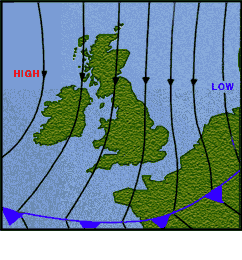
Between October and May, the air is cold enough to produce hail showers or snow, and these are most frequent over Scotland and along the coasts exposed to northerly winds. Polar low-pressure systems forming in this air mass can sometimes lead to widespread and heavy snowfall, but otherwise inland areas remain free of cloud in the winter months. In northern Scotland, arctic maritime is usually the coldest air mass, but over the rest of Britain, this air mass is not as cold as polar continental.
Arctic air is uncommon during the summer, but when it does occur it may bring heavy showers or thunderstorms and unseasonably low temperatures.
Returning polar maritime is another variation of polar maritime, but this time, with a much longer sea track which takes the air first southwards over the North Atlantic, then north-eastwards across the British Isles. A typical synoptic pattern associated with this air mass would be a slow moving low pressure in mid-Atlantic with a deep trough extending south (see Figure 10).
During its passage south, the air becomes unstable but on moving north-east it passes over cooler water making it stable in its lower layer whilst remaining unstable aloft.
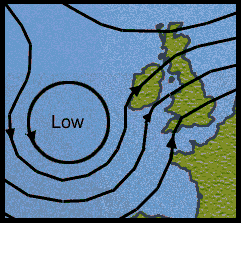
Tropical continental (Tc) | Polar continental (Pc) | |||
Summer | Winter | Long sea track | Short sea track | |
| Temp | Very warm or hot | Average | Cold | Very cold |
| Humidity | Relatively dry | Rather moist | Moist in lowest layers | Very dry |
| Change of lapse rate | Little change | Cooled from below | Heated from below | Little change |
| Stability | Generally stable | Stable | Unstable | Stable |
| Weather | Clear, occasional thundery showers | Clear | Rain or snow showers | Clear |
| Visibility | Moderate or poor | Moderate of poor | Good | Moderate or poor |
Tropical maritime (Tm) | Polar Maritime (Pm) | Arctic Maritime (Am) | Returning Polar Maritime (rPm) | ||
Exposed | Sheltered | ||||
| Temp | Near sea temperature | Warm | Rather cold | Cold (colder than Pm) | Warm (warmer than Pm) |
| Humidity | Very moist | Moist | Moist | Fairly moist (not as moist as Pm) | Fairly moist (not as moist as Pm) |
| Change of lapse rate | Cooled from below | Warmed in summer | Heated from below | Heated from below | Heated from below |
| Stability | Stable | Stable aloft | Unstable | Unstable | Unstable |
| Weather | Low cloud, drizzle | Broken cloud, dry | Variable cloud, showers | Showers (mainly coastal) | Showers (mainly coastal) |
| Visibility | Often poor with coastal fog | Moderate | Good | Very good | Very good |
Table 1. Typical characteristics of the six major air masses which affect the British Isles.
3. Between the air masses
We have looked at the individual types of air masses in some detail, but what is just as, or perhaps, even more important for weather forecasting is what happens in the immediate region where the air masses meet. As we have seen, the air masses have quite different properties so when they meet, perhaps one is cold dry and dry and the other is relatively very warm and moist. These differences produce a reaction in a zone known as a front.
The pioneer in the study of frontal development was Vilhelm Bjerknes, a Norwegian scientist, who analysed their formation around the time of the Great War. The war cut Norway off from outside weather information, so a geophysical institute was founded by Bjerknes in Bergen. He also persuaded the Norwegian government to install a dense network of surface observing stations to provide data for his meteorological studies.
It was known at this time that areas of organised rain were often related to confluence lines in the surface wind field. In 1919, at the age of 22, Vilhelm’s son, Jacob, published an eight-page paper, which introduced the concept of warm, cold and occluded fronts that correctly explained their relationship to extra-tropical depressions.
The term front was introduced as an analogy to the recent war, with air masses, rather than nations, coming together with fronts between air masses compared with the fronts where opposing armies came into contact. By 1926, in collaboration with others at the institute (know collectively as the Bergen School), Bjerknes described the structure and life cycle of frontal depressions.
In recent years, satellites, radar and numerical modelling techniques have provided additional information that has shown that the Norwegian concepts are very simplistic. They do, however, provide a helpful starting point for analysing and forecasting the weather in temperate latitudes.
Fig 11: Vertical cross section through a warm sector of a depression
3.3 Models of mid-latitude depressions
The Bergen School, led by Bjerknes, devised a simple model that shows how depressions, or low pressure systems, develop in mid-latitudes as warm and cold air masses meet. Their model has the following stages.
Origin and infancy – a warm air mass, such as tropical maritime or tropical continental meets a cooler air mass, such as polar maritime or polar continental.
Fig 12: Origin
Maturity – the warm air rises and spirals up in an anticlockwise manner over the sinking cold air. A distinctive warm sector exists between the warm and cold fronts.
Fig 13: Maturity
Occlusion – the warm sector disappears, as the cold front quickly advances. Its faster movement is because the cold front is the leading edge of cold, denser air, pushing up the warmer lighter air. It is harder for the warmer, lighter air at the warm front to cause the cooler, denser air to sink. Hence, the warm front advances at 20 to 30 miles per hour, whilst the cold front can move forward more quickly at 40 to 50 miles per hour.
Fig 14: Occlusion
Death – the frontal system dies as the warm air has completely risen and cooled, and is now underlain by the cold air. The differences in temperature have therefore been equalled out, and the occluded front disappears.
Frontal systems tend to occur in ‘families‘, which migrate in an easterly direction across the Atlantic. Sometimes as many as four or five mature depressions may make their way across the United Kingdom, before a ridge of high pressure builds up to prevent any more from advancing over the country. The origin stage tends to occur over the mid-Atlantic, with the mature stage occurring over the United Kingdom.
The death stage usually occurs over the European mainland and Scandinavia. The depressions follow the zigzag path of the fast jet streams in the upper troposphere. The jet streams may blow at 120 miles per hour in the upper troposphere, but the weather systems below it will usually move more slowly, often at about 40 miles per hour.
Britain’s changeable and damp climate is largely the result of the frequent movement of the rain-bearing fronts across the country. The regularity of their passage, and the standard sequence of changes they produce, allow quite accurate forecasts to be made.
3.4 The passage of a mature depression across the United Kingdom
Fig 15: The passage of a mature depression
The passage of a mature depression across the United Kingdom will produce the following sequence of weather changes.
Ahead of the depression in the cold sector
High cirrus clouds may occur in long feather-like streaks. Some cirrostratus may also occur up to 600 miles ahead of the surface position of the warm front. As the front approaches, temperatures start to rise, and barometric pressure falls steadily.
The warm front passes over
Drizzle and then rain will usually start to fall from altostratus and nimbostratus clouds. The amount of cloud will increase and the cloud base will fall. Continuous rain will persist as pressure carries on falling.
In the warm sector
Pressure stabilises and the amount of cloud falls as the clouds start to thin out. The precipitation also stops, and the weather is generally fine, with a little stratus or stratocumulus. As the cold front approaches, pressures slightly rise and temperatures start to fall slightly.
The cold front passes over
Large, towering cumulonimbus clouds develop as the cold front passes over. This produces heavy downpours of rain and fierce squalls, sometimes with hail and thunder. Pressures rise steadily and air temperatures start to drop as the cold front passes over.
Behind the cold front
There is an end to the heavy rain as the cumulonimbus clouds move away. Barometric pressure continues to rise in a steady fashion. A few showers may occur from some small cumulus clouds, but it is generally fine and cool behind the cold front.
4. Questions
1. Make a simple definition of the following terms.
(a) Air mass.
(b) Front.
2. Which of the following statements is true?
(a) Tropical air is stable because it is heated from below.
(b) Tropical air is unstable because it is heated from below.
(c) Polar air is stable because it is cooled from below.
(d) Polar air is stable because it is heated from below.
(e) Polar air is unstable because it is cooled from below.
3. Explain the thermal differences which will occur when:
(a) an air mass has a maritime track;
(b) a cold air mass moves over a warmer surface.
4. What are the four main types of air mass that affect the UK?
5. Which of the following are the other two subdivisions of air masses which affect the UK?
(a) Arctic maritime.
(b) Returning polar continental.
(c) Returning polar maritime.
(d) Arctic continental.
6. Explain how initially dry tropical continental air may acquire enough moisture to produce precipitation.
7. Where is the source region for polar maritime air, and what synoptic situation would allow it to flow over the United Kingdom?
8. Outline the weather features that the UK might experience with returning polar maritime air.
9. Explain why arctic maritime air is likely to lead to good visibility over much of the UK.
10. Which air mass is most associated with thundery showers?
11. Which group of meteorologists first produced a model of frontal development. Was it the:
(a) Bristol School,
(b) Brighton School,
(c) Bergen School, or
(d) Berlin School?
12. Why was the term ‘front’ used as an analogy to describe the leading edge of an air mass?
13. Which air mass would move over the UK if pressure was high over Scandinavia and there are surface winds from the east?
14. Which air mass is most likely to produce daytime temperatures, during the summer, in excess of 30 °C?
15. Which air mass is most likely to lead to temperatures at night falling below -10 °C?
16. Outline the features and cloud types associated with the following.
(a) Cold front
(b) Warm front
(c) Occluded front
17. Why does the cold front move faster than the warm front?
More information on air masses
Web page reproduced with the kind permission of the Met Office

